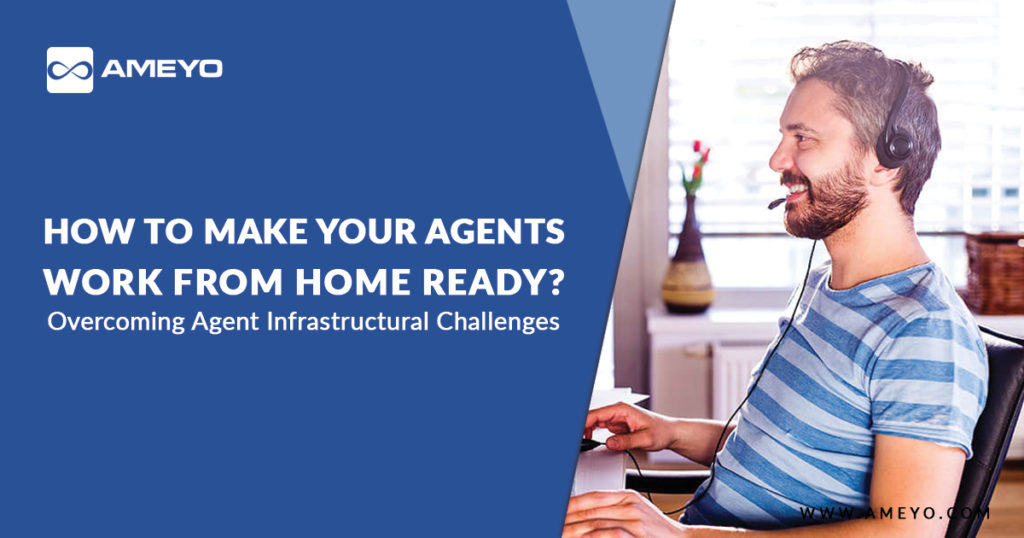COVID-19 pandemic has hit the world hard. Whether it be individuals, businesses, economy – everything has been impacted. And truth be told, the world will take some time to recover from the aftermath of the Coronavirus. However, there is no need to be disheartened. Problem gives birth to a solution.
We recently conducted a webinar (check out the webinar here) addressing remote working challenges faced by the contact centers today while offering solutions to overcome them.
Challenge 1: Infrastructural Readiness
When the call center agents are working in the purview of an IT environment where all the systems like laptops, stable internet connection, and other software and hardware infrastructure are in place, things are much simpler and it’s easier. However, once the agents are outside their workplace and working from home, they might not have all the infrastructure available to them. This is particularly true in the emerging geographies where stable high-speed internet and laptops for all the call center agents might be a challenge.
Challenge 2: Speed of Deployment
Businesses today are looking for solutions that can be deployed fast – within hours as companies already have their strategic business continuity plans in place. They do not want complex and slow to implement solutions. So, it is important for the remote call center software providers to package their solutions in such a way that they offer maximum capabilities with the fastest implementation cycle.
Challenge 3: Remote Monitoring of KPIs
Monitoring the KPIs and agent performance is as it is a critical function for any contact center. However, this becomes even more critical when you are working remotely and not having your usual meetings and daily sync-ups. Thus, remote monitoring is a critical function in the WFH setup.
Challenge 4: User or Agent Onboarding on New Methodologies
When the agents and supervisors are working remotely it becomes important to have solutions that are simple to understand and train your workforce. You do not want a complex call center software that only makes it that much more difficult to onboard the agents.
Also Read: How to Build a Cost-Effective Remote Contact Center
We Got You Covered – Ameyo’s Immediate WFH Solutions
Keeping in mind the current situation and the needs of the businesses, Ameyo has come up with immediate WFH solutions to help businesses do remote faster. These solutions are primarily categorized based on the infrastructure available to the agents.
When Your Agents Have Laptops + Stable Internet
Well, this is the best case scenario – the agents have a laptop and great internet connection. They can just set up a corporate VPN and all the customer communications can be done via the VPN itself using WebRTC. Even in case of the organization not providing the VPN, Ameyo can provide it and integrate into your corporate network or any CGI application. Since all the data is saved on the server and the solution is browser-based, you do not have to worry about data security or the same being stored on the agent’s system.
When Your Agents Have Laptops but No Stable Internet
This is a situation when your agents have access to a laptop but do not have a reliable internet connection. That is a VPN or enterprise level bandwidth is not available so you cannot route calls to the remote agents over WebRTC. With Ameyo’s solution, you can actually route the calls on the PSTN network to the agent’s mobile while having the CTI being displayed on the laptop. Thus, when the agent receives a call on their GSM handphone a CTI pop-up will appear on the laptop screen and the agent can continue the conversation while enjoying all the telephony features. At the same time, the supervisor can remotely monitor the operations in real-time with live monitoring tools and dashboards.
When Your Agents Have only Smartphone
Ameyo has launched Industry’s first Mobile Agent App which requires zero agent infrastructure while providing complete call center capabilities like predictive dialer, progressive dialer, CTI, WebRTC, telephony features and remote monitoring to name a few. With this call center on mobile solution, the agents can monitor their pending tasks, scheduled callbacks, and receive calls on the GSM network in addition to a CTI popup in the application itself. You can also get critical information to be shown in the CRM or your back-end systems while allowing the agents to take notes and dispose calls. Call recordings are again happening on the cloud. There is nothing getting stored on the agent’s mobile phone. You don’t even need to expose the customer’s phone numbers to the agent’s mobile.
When Your Agents have a Feature Phone Only
This brings us to a situation when the agents do not have laptops, don’t have a smartphone and neither do they have internet connection. Ameyo has come up with a specific solution wherein the agents can login to the call center using an IVR. How this essentially works is that the agents are assigned individual login credentials and an IVR number which they can call and punch in their credentials. Once they have logged in, they will be receiving inbound calls based on their availability and skill. That’s not all – the agents can even make outbound calls via the IVR. They simply have to call the IVR number, dial in the customer number and an outbound call will be dialed out. The call recordings will still be saved on the server and nothing is stored on the agent’s phone.
Looking to setup your remote contact center? Get in touch with us today





